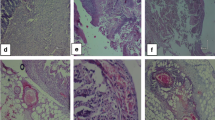Summary
The healing of intestinal anastomoses has many physiological, biochemical and morphological aspects. In each stage it can be disturbed or blocked. Nearly each factor of normal healing can under changed circumstances, favour anastomotic dehiscence. Dehiscence can be caused by one severe disturbing factor; in most cases, however, there is more than one factor that forms rupture of the anastomosis. The intestine itself can become a disturbing factor as well as changed biological circumstances and last but not least insufficient tactics and techniques of building an anastomosis.
Zusammenfassung
Der physiologische, biochemische und morphologische Heilungsvorgang der Anastomose ist außerordentlich komplex. Er kann in jeder Phase nachhaltig gestört bis blockiert werden. Nahezu alle Bauelemente sind unter veränderten Konditionen geeignet, eine Insuffizienzentstehung zu begünstigen. Die Insuffizienz kann Folge eines einzelnen gravierenden Störfaktors sein, meist ist sie jedoch das Produkt eines Faktorensynergismus. Gravierende Störfaktoren finden sich im Organsystem Darm selbst, in veränderten biologischen Voraussetzungen und nicht zuletzt in der unzureichenden Taktik und Technik.
Similar content being viewed by others
Literatur
Amshel AL (1977) The use of vicryl sutures in colonic and rectal surgery. Dis Colon Rect 20:635
Bary SS v, Kortmann H, Hefele U (1979) Die fibrinolytische und kollagenolytische Aktivität des Dickdarmes. Therapiewoche 29:936
Crowson WN, Wilson CS (1973) An experimental study on the effects of drains on colon anastomoses. Ann Surg 39:597
Dunphy JE (1971) Preoperative preparation of the colon and other factors affecting anastomotic healing. Cancer 28:181
Eichfuss HP, Eckert P (1978) Nahttechnik und chirurgisches Nahtmaterial. Aktuel Chir 13:73
Eichfuss HP, Kremer B, Lierse W, Schreiber HW (1982) Chirurgische Nahtlager am Rumpfdarm. Aktuel Chir 17:25
Everett WG (1975) A comparison of one layer and two layer techniques for colorectal anastomosis. Br J Surg 62:135
Fielding LP, Brown S, Blesorsky L, Kearney G (1980) Anastomotic integrity after operations for large bowel cancer, a multicentre study. Br Med J 9:411
Goligher JC, Morris C, McAdam WAY, Dedombal FT, Johnston D (1970) A controlled trial of inverting versus everting intestinal suture in clinical large bowel surgery. Br J Surg 57:817
Hawley PR, Fauck WP, Hunt TK, Dunphy KE (1970) Collagenase activity in the gastrointestinal tract. Br J Surg 57:896
Hell K, Allgöwer M (1976) Die Colonresektion. Springer, Berlin Heidelberg New York
Herzog B (1974) Die Darmnaht. Huber, Bern Stuttgart Wien
Kerscher P, Wünsch PH, Steidl H (1979) Naht der Submucosa bei der Dickdarmanastomose. Chirurg 50:770
Langer S, Peters H (1976) Nahtinsuffizienz und Wundheilungsstörung in der Dickdarmchirurgie. In: Häring R (Hrsg) Aktuelle Probleme des Kolon- und Rektumkarzinoms. Aktuel Chir, Bd 2, Straube, Erlangen
Langer S, Haberland R, Breinig H (1976) Die Dickdarmanastomose und ihre Abheilung unter massiver Bakterienkontamination. Langenbecks Arch Chir 341
Pollock AV (1980) Probleme der Kolon-Anastomose. Proktologie 1:23
Ravitch MM, Brolin R, Kolter J, Yap S (1981) Studies in the healing of intestinal anastomoses. World J Surg 5:627
Reifferscheid M, Peters H (1978) Präoperative Maßnahmen in der Rectumchirurgie. Chirurg 49:257
Schrok TR, Deveney CW, Dunphy JE (1973) Factors contributing to leakage of colonic anastomoses. Ann Surg 177:513
Stelzner F (1977) Operationstechnisch bedingte Mißerfolge bei der Behandlung des Kolon- und Rektumkarzinoms. Zentralbi Chir 102:1559
Thiede A (1978) Nahtmaterial in der Chirurgie. Fortschr Med 96:883
Thiede A, Troidl H, Poser H, Jostarndt C, Hamelmann H (1980) Prospektive Studie zum Auto-suture-Klammernahtgerät für Kolon- und Rektumanastomosen. Zentralbl Chir 105:825
Whitaker BC, Dixon RA, Greatorex G (1970) Anastomotic failure in relation to blood transfusion and blood loss. Proc R Soc Med 63:751
Author information
Authors and Affiliations
Rights and permissions
About this article
Cite this article
Langer, S., Kupczyk, D. 41. Entstehung der Nahtinsuffizienz. Langenbecks Arch Chiv 358, 253–258 (1982). https://doi.org/10.1007/BF01271793
Issue Date:
DOI: https://doi.org/10.1007/BF01271793




